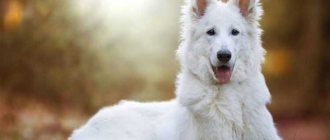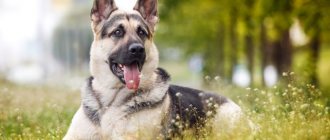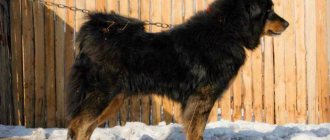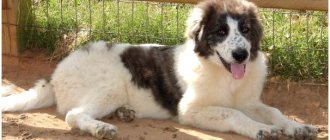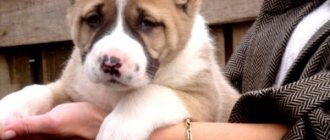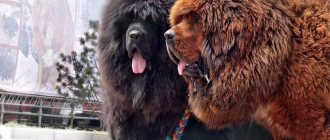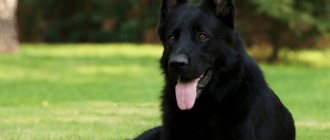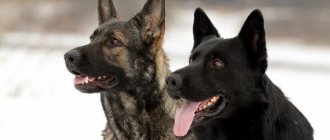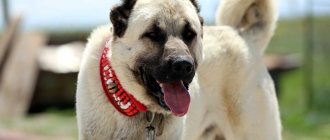The owner of a four-legged pet is always interested in how correctly his pupil is developing. Therefore, the question of how old a dog of this breed grows is not idle. Every owner also needs to know how many grams a puppy should gain monthly and how many centimeters it should grow. The pet's parameters must match the average.
Breed standard
The East European Shepherd must meet the following parameters:
- the dog's head has a wedge-shaped muzzle, narrowing in the lobe area, without points;
- jaws with 42 teeth and a scissor bite;
- nose with a flat back, massive black-charcoal nose;
- oval-shaped eyes with medium size, wide set, dark iris color;
- erect ears of medium size, triangular, rounded at the tips;
What does an East European Shepherd look like?
- the neck is muscular, gradually widening towards the shoulders;
- the body is balanced, rectangular, the stomach is tucked, the chest is oval;
- the paws are straight, parallel, the hind limbs are more massive;
- the tail is saber-curved, lowered in a calm state;
- a coat with an undercoat of a lighter tone, a semi-long awn of a dark shade, a thick coat helps pets feel great both in the Middle Eastern region and in Kamchatka and the Far East.
For your information! The acceptable colors of the European Shepherd are black and red, black and gray and black. The standard also allows light (but not white) areas that differ from the main color in the area of the eyes, paws, cheekbones, and under the tail.
Comparison with the German Shepherd
There are no fundamental differences between dog breeds, but there are minor changes:
- a “German” male is similar in size to an Eastern European female;
- The VEO dog has thicker and more massive paws;
- Eastern European dogs are calmer, while “Germans” are more active and playful;
- German Shepherds are more service dogs; their European counterparts are more often used as a companion.
Important! The main difference is the way the dog moves. The Western European breed has a long stride and short trot, while the Eastern European breed has a heavy and sweeping gait.
German and East European Shepherds
A little history
As mentioned above, the East European Shepherd was created on the basis of the German breed, but it is still different from it. The difference lies in a stronger body build, mental stability and balance of temperament, as well as the ability to more easily endure harsh winter conditions.
Advertising:
The appearance of the first German Shepherds dates back to the beginning of the last century - they were used as service dogs and orderlies in the Russian-Japanese and First World Wars.
As a result, the high qualities of this breed were recognized, and in 1924, the breeding of a new species based on it began - it was planned that the newly bred breed would participate in border troops, search activities and rescue operations. And after the Great Patriotic War, the East European Shepherd became one of the most common service breeds in the Soviet Union.
The East European Shepherd is one of the breeds that originated in the former Soviet Union.
The breed was officially recognized by dog handlers in 1964 - and a lot of discussions arose about the properties of the bred dogs. There were many dog breeders who claimed that the “newbies” were inferior in characteristics to the Germans.
At one time, some breeders tried to improve the breed by crossing new Germans with Eastern Europeans, but these attempts were essentially unsuccessful. Classic VEOs significantly surpassed the German breed in their characteristics, so additional crossings did not yield anything.
In the 90s, after the Soviet Union ceased to exist, there was a certain crisis situation in this regard - after all, the East European Shepherd Dog is recognized only in Russia - they refuse to recognize it abroad. In this regard, there was a sharp drop in demand and a decrease in the number of people willing to engage in this breed.
Today the situation looks somewhat better - within the country, the East European Shepherd has many connoisseurs who are ready to make every effort to provide it with the necessary conditions for its continued existence.
The East European Shepherd is recognized only in Russia
Features of character and behavior
The Eastern Shepherd has a more phlegmatic and reasonable disposition. She is not harsh or hot-tempered, but knows how to make decisions and act instantly. Compared to close relatives, pets have greater intelligence and do not get involved in fights without a reason.
Attitude towards children and other pets
Caucasian Shepherd Wolfhound: characteristics of the breed
The animals are good-natured and sincerely become attached to the kids. Pets who permanently live with an Eastern European dog cannot complain about being treated poorly.
Important! The main problem is meeting a stray cat or dog while walking. The dog may react inappropriately, so when walking, constant monitoring of its actions is required.
During a walk, a dog may attack a yard cat.
Dogs' attitude towards strangers
The VEO dog breed is hostile towards strangers, and it is impossible to eradicate this habit. The animal will not immediately rush to the object of hatred, but only under the condition of proper upbringing and completion of the full course of OKD. Young individuals have difficulty distinguishing between friendly gestures and the danger of a noisy company, including a defender at the most inopportune moments.
Note! According to the characteristics of the breed, the dog is not the first to attack; most often it obeys the owner’s command or protects him in a critical situation.
Attitude towards the owner
Pets strive to be useful, sometimes their attempts to guard their beloved owner reach the point of absurdity. Males do not seek to impose their status as an alpha male; the role of a companion suits them. The distribution of roles in the house should occur immediately after the baby appears in the house, otherwise the dog may decide that it has encountered a spineless owner. The issue will end in stubbornness and disobedience.
For your information! A dog will not compete for a person's love with other animals. He does not waste his time on meaningless fights and showdowns.
Training and raising a dog
Black German Shepherd: characteristics, what is it called
VEO Shepherd dogs have excellent intelligence, they easily pass the standard OKD course. Unfortunately, with this breed you will have to constantly repeat the skills acquired in the courses. Over time, the dog may forget the rules of good behavior and begin to ignore commands.
Important! The dog considers the trainer to be its owner, and not the one who feeds it.
You need to train from the first days the baby appears in the apartment. Daily exercises should be given 15 minutes, since at a young age pets cannot concentrate on commands, get tired quickly and start having a fun romp.
Dog training should be done daily
From the age of three months, young animals are taught to obey during walks. Puppies should not be distracted by extraneous stimuli in the form of cats or littermates. At 4 months, the pet is taught to overcome barriers and search for hidden objects by smell. At the age of five months, a service course begins with the protection of things and the detention of the offender. It is not included in the mandatory program; the dog is trained only at the insistence of the owner.
Head
Proportional to the body: massive and moderately long. It is shaped like a slightly pointed wedge. The transition from forehead to muzzle is not too pronounced. At the same time, it is clearly visible. The dark-colored lips fit tightly to the jaw. The nose is always black. The ears are shaped like an isosceles triangle, set high and erect. Almond-shaped eyes can be either dark or light. The photo of the East European Shepherd, located below, allows you to appreciate the look of the animal - confident and intelligent.
Important features of care and nutrition
A dog requires a sufficient amount of free space; keeping it in a city apartment can lead to difficulties. The animal's bed should be in a quiet, secluded corner and not interfere with the walking of members of the household. The mattress should be semi-rigid, food bowls should be on adjustable stands, which will reduce additional stress on the dog’s joints.
Polish Podgalian Sheepdog: description of the dog breed
A suitable option is to keep your pet in an insulated enclosure of sufficient size so that he can freely stretch his paws in it. The booth must be treated for parasites every six months, not forgetting about the monthly washing of the bed. The only maintenance requirement is combing your long-haired pet during spring shedding.
Important! The breed does not react well to chains of any length. It will cause the animal to distrust its owner and anger at the entire world around it.
Feeding is carried out according to the standard: the owner can use ready-made industrial feed or natural food. In the latter case, you will have to buy additional multivitamin complexes to avoid problems with vitamin deficiencies.
Walking and physical activity
The walk should take place in a forested area or places where there are no passers-by. Walking every day takes from 1 to 2 hours, the dog should run around and stretch as much as possible. Dog handlers advise jogging and engaging in any sports, including water sports.
Important! Sick or cold pets should not exercise or take long walks. In the first 12 months of a dog’s life, jumping is contraindicated to avoid injury to fragile joints.
Active games with a dog
Feeding rules
European Shepherds are not picky, but they require special nutrition that can provide essential microelements for life. The dog is active, constantly on the move, it requires increased protein and vitamins.
The most ideal way would be to feed dry food 2 times a day; it is already balanced and contains everything a dog needs.
- Adult shepherds and VEO puppies eat differently. Puppy eats 5-5 times a day, in small portions, and adults 2 times a day, in large portions. Water must always be available.
Feeding is best done before a walk; the portion should be appropriate for age and activity. The advantage of premium feed is ease of use, clear calculation of the amount of feed in grams.
You cannot feed your pet human food, it is not able to give him everything he needs. It is strictly forbidden to give:
- Tubular bones - can injure the esophagus, intestines and stomach;
- Spicy, sweets, bread, salty, peppered, fried;
- Fat meat;
- Citrus;
- Candy and any other sugar.
Some sources indicate that the dog should not be walked once after feeding, I would like to draw attention to this - this is a lie, the pet should be walked immediately after feeding.
If you feed your dog natural food, you must correctly calculate his diet, the amount of proteins, fats and carbohydrates, plus add minerals and vitamins. Unfortunately, this can only be done by a specialist with a veterinary education, so it is recommended to contact him, or choose premium dry food - class type “Pro-plan” or “Go”.
Dog life expectancy and health
Common dog breed diseases include:
- volvulus of the stomach. Occurs when feeding a pet large portions;
- joint pathologies, ranging from classic dysplasia to arthritis formed due to physical inactivity and excess weight;
- glaucoma;
- turning of the eyelids.
The average life expectancy of VEO dogs is between 12-16 years, some dogs do not survive the 10-year mark. The problem is often associated with hereditary diseases.
Theses
- This is a service breed, created for work and stress. Because of this, it is less suitable for living in an apartment, preferably a private house and a large yard. If the owner keeps the dog busy enough, he will be able to live in an apartment.
- VEOs are smart, but they only listen to those whom they consider to be higher in status than themselves.
- They are attached to one person and may completely ignore others.
- They shed a lot.
- They are not particularly suitable for families with children, as they avoid them and often do not understand them.
- They get along with other dogs, but can attack small animals.
Dog mating
The description of the East European Shepherd breed states that the age considered favorable for breeding is:
- for males - 2 g;
- for bitches - 20 months.
When planning the first mating, you need to take into account the individual characteristics of the body. In some animals, physiological development ends earlier; in others, formation takes longer. The main indicator of sexual maturity in females is considered to be the period of the third estrus, during which mating is carried out.
The physiological process first occurs for girls at 8-12 months, subsequent ones occur at intervals of six months. The average estrus time is 18-20 days.
Important! When breeding dogs, partners are selected based on pedigree and health indicators. The slightest deviations can cause the birth of sick babies.
Table of height and weight of the VEO puppy by month
The VEO puppy begins to resemble an adult in size and body weight by 8-9 months of age. Until the end of the first 12 months, muscles continue to form in animals, and the volume of subcutaneous fat increases.
For your information! The final build depends on the genetic predisposition and quality of feeding of the young.
| Age in months | Height at withers in cm | Weight in kg |
| First | 23-27 | 3-5 |
| Second | 33-38 | 8-10 |
| Third | 41-47 | 12-15 |
| Fourth | 48-55 | 15-20 |
| Fifth | 55-60 | 20-25 |
| Sixth | 57-65 | 25-30 |
| Seventh | 65-68 | 30-35 |
| Eighth | 66-70 | 35-40 |
Over the next 4 months, the purebred dog reaches a maximum height of 75 cm and body weight of up to 40 kg.
Puppy
How to choose an East European Shepherd puppy, kennels and prices
When choosing a dog, you must adhere to the following rules:
- getting to know the mother of the offspring will help to assess the temperament that will be passed on to the young. If the dog is poorly controlled and aggressive, then such hereditary baggage is the worst option;
- The bitch's dissatisfaction is a natural instinct to protect the offspring. The dog may bark, but should not attack guests;
- When purchasing, you must familiarize yourself with the OKD and ZKS diplomas of the puppy’s parents. In most cases, young animals repeat the exploits of the older generation;
- If a companion is needed, then the most frisky puppy with the habits of a leader is not suitable. It is recommended to take a calm, but not cowardly baby;
- It’s not worth buying raised pets; not everyone is able to cope with the difficulties of re-education. Adaptation for an adult dog is difficult.
The average cost for a baby depends on many factors:
- RKF metric - from 15 to 20 thousand rubles;
- Diplomas in ZKS and ODC from parents of champions - from 25 to 35 thousand rubles*
Important! You need to purchase a future family member from a nursery. From the hands of private individuals, you can buy a completely inadequate and sick animal with serious mental disorders, which will look like a healthy individual.
Well-known organizations include:
- "VeoVitu" (Moscow);
- "Strong Outpost" (Smolensk);
- “The Pride of Stalingrad” (Volgograd);
- "Valentlife" (Moscow);
- "Zhanetline" (Yaroslavl);
- "Grey-haired Ural" (Ekaterinburg);
- "Peaceful House" (Chelyabinsk);
- "Omsk Squad" (Omsk).
Before visiting the organization, you need to read customer reviews and get advice from a professional dog handler about the characteristics of the Far Eastern Shepherd. Inexperienced beginners should go for a future pet with an experienced dog walker who knows how to identify defective or sick babies.
Learning to choose a puppy
Before you choose a puppy of the Eastern European breed, ask yourself what you need it for - for home, for service, for protection, or to win medals at exhibitions. In the first case, you don’t have to worry about the pedigree - if you need a good friend, buy yourself a cute and cute East European Shepherd puppy, even if he doesn’t have well-deserved parents.
If you need a puppy to train as a champion or for a rescue service, you will have to be more picky. Study his pedigree well - if the parents showed good results in the professional field, these skills will most likely be passed on to the baby.
To participate in exhibitions, you will need to seek advice from dog handlers - they will help you choose deserving parents and show which of the puppies has a chance of becoming a celebrity.
Choosing an East European Shepherd puppy
What to name a dog
The name of the Central European Shepherd should be simple, without complex double or triple prefixes. Light names are easier for animals to understand.
Boys are usually called: Scarlet, Azart, Buyan, Baikal, Whirlwind, Faithful, Proud, Hamlet, Jack, Leon, Lord, Count, Sultan.
More suitable for girls: Atlanta, Bagheera, Vega, Volna, Gerda, Eva, Delta, Irma, Iskra, Ursula, Hana.
Important! The nickname of the East European Shepherd depends on the imagination of the household and the ease of its pronunciation. Each owner chooses a name for the dog independently, regardless of what is indicated in the pedigree.
Pros and cons of dog breeds
There are no dogs without positive or negative qualities. Much depends on the timeliness of upbringing, socialization and the atmosphere in the family. Cynologists highlight the following traits of pets:
| pros | Minuses |
| high intellectual level | need for education |
| devotion to family and master | need for long walks |
| equilibrium | need daily exercise |
| obedience | distrust of strangers |
| good defensive reactions | expensive maintenance |
| good attitude towards younger family members, lack of jealousy | hereditary joint diseases |
| quick learning of the basics of training |
The Eastern European breed is intelligent, reserved and does not cause problems in the family if raised correctly.
You can leave her with small children without fear for their health. Pets do not strive for leadership, but may try to take the place of the alpha male with a weak-willed owner. Before purchasing, you need to realistically assess your financial capabilities. A shepherd dog is not an Italian greyhound; feeding it requires serious material costs. *Prices are as of November 2022.
Reviews
- Maxim, 30 years old, Sevastopol.
My shepherd is more than just an animal, it is a partner, a friend, a family member. We work in the police, we have gone through a lot of different situations, I am always confident and calm.
- Veronica, 34 years old, Moscow.
They gave me a puppy for my birthday, I got so involved that I threw myself into training, exhibitions, became a professional handler, now I am breeding, I already had my first litter, I am happy - the best gift of my life. My Nelya is perfect.
- Irina, 43 years old, Khabarovsk.
Very smart, incredibly smart, requires a lot of attention - manifestations of love, if she doesn’t get what she wants, she gets offended and sits in the corner for half a day. They corrected it through training with a dog handler, but were somewhat surprised. Sometimes he steals, but he does it cunningly - you can’t dig into him, it makes him very funny, it seems like he’s spoiled himself.
